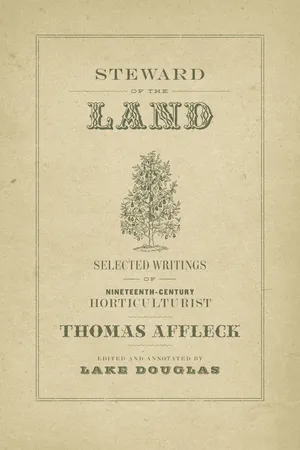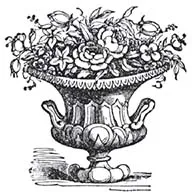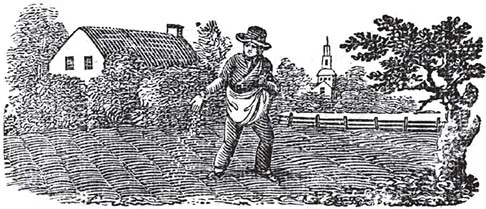![]()
II
SELECTED WRITINGS 1840–1869
![]()
3
From Western Farmer and Gardener
American agricultural newspapers and journals were published first in the New England states, but as people moved west, so did newspapers and journals. One of the first and most influential was the Western Farmer and Gardener, published first in Cincinnati from 1839 to 1845, when it ceased publication because of the failing health of its primary editor, Edward J. Hooper. In 1846, the Western Farmer and Gardener was combined with the Indiana Farmer & Gardener of Indianapolis and continued publication as the Western Farmer & Gardener under the joint editorship of Hooper in Cincinnati and the Reverend Henry Ward Beecher in Indianapolis.1 The paper’s focus shifted to the Indianapolis region, and there were few articles related to locations, crops, or climates outside that region; the paper soon lost its southern readers. Beecher became sole editor in 1847, but issues from that year have not been found, and it is not known whether the publication continued after 1847.
The Western Farmer was popular among landowners and community leaders in its region, and it was well known for its articles on horticulture and livestock, two subjects about which Affleck wrote extensively.2 While it was published in Cincinnati, the Western Farmer had several editors: Hooper, Thomas Affleck, Charles Foster, and Charles W. Elliott. Affleck was named associate editor in 1840 and became editor in 1841, serving in that capacity until he moved to Mississippi in 1842.
As was common during this period, agricultural newspapers (or “papers” as they were then known) such as the Western Farmer contained original staff reporting, contributions from subscribers, and articles reprinted from other publications of the period, such as the New England Farmer (Boston, 1822–46); the Cultivator (Albany, New York, 1834–97); the Maine Cultivator (Hallowell, Maine, 1839–50); and the Agriculturist (Nashville, Tennessee, 1840–45). The Western Farmer sent Affleck on extended trips, first through Kentucky and other neighboring states and then to Mississippi and Louisiana, with the purpose of making first-hand observations about agricultural conditions (both crops and livestock) and activities (including fairs, conventions, and societies) in these areas. His reports were then published.3
Representing the Western Farmer, Affleck doubtless sought to enlist new subscribers, since there were no regional sources of agricultural information readily available for residents of the states that he toured. In reading his reports, one concludes that Affleck was personable and congenial. Judging from names he mentions, we learn that he quickly became acquainted with community leaders, landowners, and people of influence and social prominence in the communities he visited. An entrepreneur, Affleck had taken some of his own livestock with him to show and sell at the agricultural fairs he visited as a way of promoting his credibility (and that of the publication he represented), advancing current practices of animal husbandry, and making money. He also met his future wife in the Natchez area while on his visit there. He left Cincinnati and the Western Farmer in 1842, moving south to marry her and manage her plantations, which, he soon found, were in financial and agricultural disarray.
Affleck likely realized that he could use his expertise in animal husbandry and horticulture, his experience as a writer and editor for the Western Farmer and editing its 1842 Almanac, and the contacts gained from his travels to generate new business opportunities in the Natchez area.4 While there were numerous American agricultural newspapers in the 1840s, most were short-lived and limited in their geographical coverage to regional audiences. Curiously, few were published in the agricultural South, and at the time none covered Mississippi and Louisiana.5
As markets changed over time, publications disappeared or consolidated to continue publication, and places of publication changed.6 Many had similar names (often with nouns such as cultivator or farmer or adjectives such as agricultural and horticultural in their titles), making it difficult today to track evolutionary chronologies.7 Complete runs of such publications are difficult to find today because production values among these “papers” were modest, if that. They were cheaply printed, and most subscribers eventually discarded copies after reading them. Nevertheless, editors urged subscribers to keep issues for future reference, and publishers often bound back issues and returned them to subscribers. In many cases, today’s examples exist because they were bound as books.8 For most of the nineteenth century, there were few institutions or libraries that collected works on this subject; hence most extant examples of these publications are single issues or bound volumes of a year’s collection of issues, and several are now available electronically.
The Western Farmer may well have been one of the most important agricultural papers of the mid-nineteenth century because of the diversity and quality of its content, and its wide regional influence. In addition, the Western Farmer was unique in that its editors extracted the “largest and best parts” of the publication and re-published the collected articles in two hard-cover editions (at 1,168 pages each) as The Western Farmer and Gardener: Devoted to Agriculture, Horticulture, Gardening, the Flower Garden, Cattle Raising, Etc., first in 1848 and again in 1850 (used here). The fact that there were two hardbound editions of these collected works suggests that the material was useful and well received by the public of the late 1840s and early 1850s in the rapidly expanding West and Southwest, the present-day states of Ohio, Indiana, Illinois, Kentucky, Tennessee, Missouri, Alabama, Mississippi, Louisiana, and Arkansas. Certainly Affleck’s contributions from firsthand observations “in the field” describing agricultural life in Mississippi and Louisiana increased readership in that region, added to the Western Farmer’s constituency, and stimulated interest in agricultural institutions such as local agricultural societies and perhaps even regional agricultural publications, such as the Mississippi Planter & Mechanic, from 1857.9
Content in these agricultural publications covers a broad range of topics related to agriculture, animal husbandry, and domestic life; some even contained “women’s departments” that covered household hints and recipes. There were also magazines devoted wholly to women’s issues, such as Godey’s Lady’s Book, published in Philadelphia between 1830 and 1878. Prior to the Civil War, Godey’s was the most popular periodical in America, with circulation in 1860 reaching 150,000. Its contents included instructions regarding sewing and needlework, poetry, short stories, and articles (mainly by women), piano music, and, notably, colored fashion plates. Curiously, however, there were few if any articles related to gardening or domestic horticulture.
Agricultural papers were the stages on which agricultural issues were presented and the forums through which agricultural reformers and their platforms became widely known. Editors were influential figures, and their publications advanced agricultural education, efficient farm management, new growing techniques, technological advancements of equipment, and “fluffing,” when manufacturers paid editors for prominent product placement and “unbiased” editorial discussion of new products.10
Politics in general and the politics of slavery in particular were hardly discussed, even though some agricultural reformers by the late 1840s and early 1850s were beginning to realize that the single-crop economy prevalent in much of the South, produced through a slave-based economy, was both agriculturally inefficient and financially unsustainable. An editorial in the Western Farmer (May 1842) addressed to “the farming community” begins: “It is part of our compact with our subscribers not to talk politics, and we believe we will not overstep our bounds in the following observations. The pressure of our times is such, that we feel compelled to notice it, and our sole object is to state a few circumstances we feel worthy [of] the attention of the farmers of the country.” The editorial then notes how much the country depends upon farmers and calls for the establishment of agricultural societies, for the careful attention to the business of being a farmer, and for “improvement, moral and intellectual.” Further, the editorial encouraged farmers to “increase the amount of their crops and improve their breeds of cattle,” thereby improving their own social condition in order to add to the “wealth of the country and elevate her standing with the world.” This was support for agricultural reform that altogether sidestepped slavery—the agricultural elephant in the country’s parlor.
Journal articles are as often signed as not, and when reprinted from other sources, credit is sometimes given, sometimes not. In the Western Farmer, authorship appears as a name or as initials, and dates and sources of original publication are inconsistently given. We may assume that articles in the bound volume of collected works are given in the chronological order in which they originally appeared; however, in this work, articles are grouped by general subject matter rather than the order in which they appear in the collected volume, with notations given of where they appear in the bound volume (1850 edition) used here.
This “Notice” appears as front matter in the Western Farmer:
NOTICE.
The “Western Farmer and Gardener” was originally published periodically, running through a series of five volumes, from September, 1839, to August, 1845, inclusive, under the management and editorship of E. J. Hooper, Thomas Affleck, Charles Foster, and Charles W. Elliot, Esqrs. The contents of this volume are made up from the largest and best part of those five; such matter being omitted as had particular references to local affairs, transpiring at the time of publication, and seeming to possess but little interest or value to the future reader.
The “Western Farmer and Gardener” is a practical book; the editors, and other able writers for the work, having had long experience in the different branches of agriculture, Horticulture, Gardening, Cattle Raising, &c., &c., upon which they treat; and the selected articles being taken from the best works and journals on those subjects, all having especial reference to the climate, soil, &c., of the South and West, and Northwest.11
In this compilation of work from the Western Farmer, Affleck’s first article is “Planting Fruit Trees,” followed by some forty more, the last one appearing in 1843 after Affleck had relocated to Washington County, Mississippi. As is evident from the titles of his contributions, Affleck wrote on a variety of subjects, including general discussions of gardens, flowers, and fruit trees; beekeeping (a particular interest, and one that appeared in 1841 as a monograph published in Cincinnati); creating agricultural societies; and efforts to improve livestock, notably hogs (another particular interest). Affleck also wrote extended pieces on conditions, concerns, and issues based on first-hand observations in Kentucky, Mississippi, and Louisiana, a narrative device employed by many during the nineteenth century (notably Frederick Law Olmsted in his journeys through the South in the 1850s). In these accounts, we see in Affleck’s words—as in those of Olmsted a decade later—an acknowledgment and appreciation of the environment together with the recognition of how the landscape might be organized for both profit and pleasure.
Throughout his career, Affleck’s writings are “in the plainest possible manner” (words he used in an early article to describe what he valued in contributions from correspondents), increasing their accessibility. The selections given, representing his early career as a journalist, are more about horticultural topics than animal husbandry. These subjects, together with others discussed in the Western Farmer and Gardener, reflect the interests of the paper’s readers and offer a window through which we can view mid-nineteenth-century American horticultural and gardening concerns.
All footnotes to the text are my own annotations, which are intended to provide additional information or context. The page numbers provided in the first note in each article reflect the pages in the Western Farmer and Gardener compilation (1850) from which the article is taken.
—Ed.
Let Us Have a Horticultural Society!12
Little towards improvement in gardening can be done without one. Witness the astonishing results of the establishment of societies in the East and in the old country. To their influence we are indebted for the many new and delicious fruits, the improved vegetables, and the beautiful shrubs and flowers which the enterprise of a few individuals has introduced amongst us—sparingly, it is true, yet enough to show us what could be done by the concentrated efforts, of even the scanty number among us who take an interest in such things. The societies established in Boston and Philadelphia have been the means of supplying the markets of those cities with an abundance of fruits and vegetables, such as we must be satisfied to hear their citizens boast of, but cannot, as yet, partake of ourselves. We are fully persuaded that the soil and climate of the valley of the Ohio, and more particularly around our own city [Cincinnati], are much better adapted to the growth of fine fruits and flowers, than in many parts of the East where they are cultivated to a great extent. We see that the Massachusetts Horticultural Society offers a premium for the discovery of some means of checking the ravages of a slug, which there infests the rose-bush to such an extent as “to rob the fairest flower in creation of its beauty.” We never heard of nor saw any such insects here: nor do we believe, that with one tenth part of the care bestowed there on their cultivation, would we have to complain of blight in the pear, yellows in the peach, nor of the ravages of the curculio or the borer, nor of many other annoyances, of which the gardener has too often cause to complain. But alas! We have greater enemies still to struggle with—neglect and indifference. We have apples, pears, and peaches, vegetables and flowers, such as they are; some few are good, but by far the greater part unworthy of garden room. All this can be remedied. Let the gardeners bestir themselves— excite each other to take more interest in their profession, and, by the establishment of a Horticultural Society, become acquainted with each other, and with the progress in improvement they have individually made, and with that made elsewhere—by the exhibition of fruits, vegetables and flowers, and giving premiums for the best specimens of each, “stimulate and reward industry and enterpr...




